This Kung Pao Spaghetti recipe is a sweet and spicy copycat variation of a Chinese fusion favorite at CPK. Flavorful pasta, chicken, and veggies are slathered in an easy homemade kung pao sauce, then topped with peanuts and spring onions for a family-friendly dinner ready in just 30 minutes.
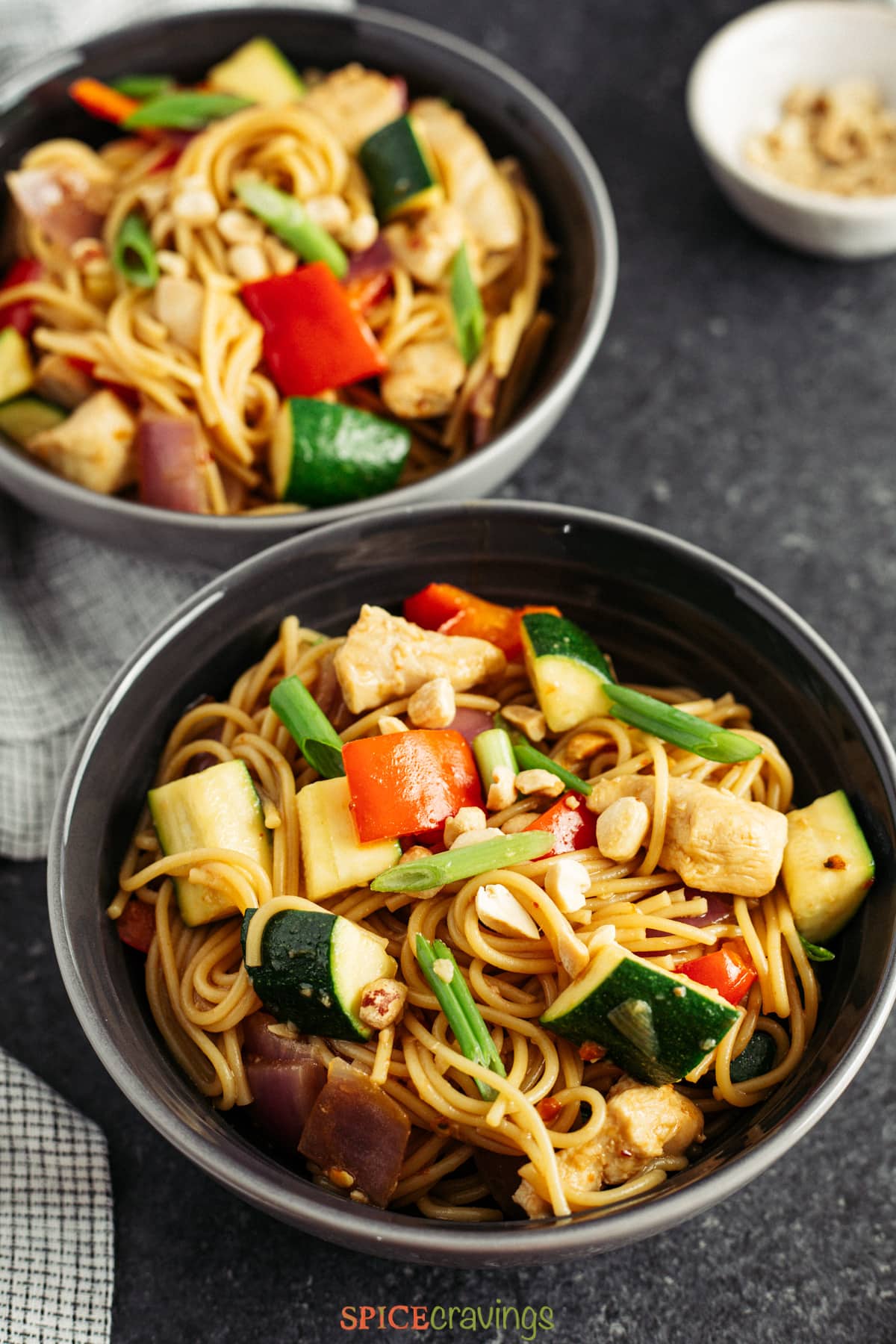
Jump to:
What Is Kung Pao Spaghetti?
California Pizza Kitchen has a delicious, spicy Kung Pao Spaghetti that is absolutely to die for. Made with spaghetti, chicken, and veggies drenched in sweet and spicy Kung Pao sauce, it's an incredibly flavorful meal.
However, at $18 a dish, it's definitely not a cheap meal! This recipe is my humble, budget-friendly take on this crowd-pleaser along with an easy option to make it vegetarian.
This CPK Kung Pao Spaghetti embraces the authentic flavors of Kung Pao chicken (also called Gong Bao or Kung Po), a spicy stir-fried Chinese dish made with chicken, peanuts, veggies, and chilis.
Why You'll Love This Recipe
- The Instant Pot makes this an easy, one-pot meal that takes just 30 minutes.
- It adds a fun Asian twist to the usual spaghetti.
- It's budget-friendly.
- Can easily be made vegetarian.
- This recipe is family-friendly and a total crowd-pleaser and can be tweaked to be as spicy as you like.
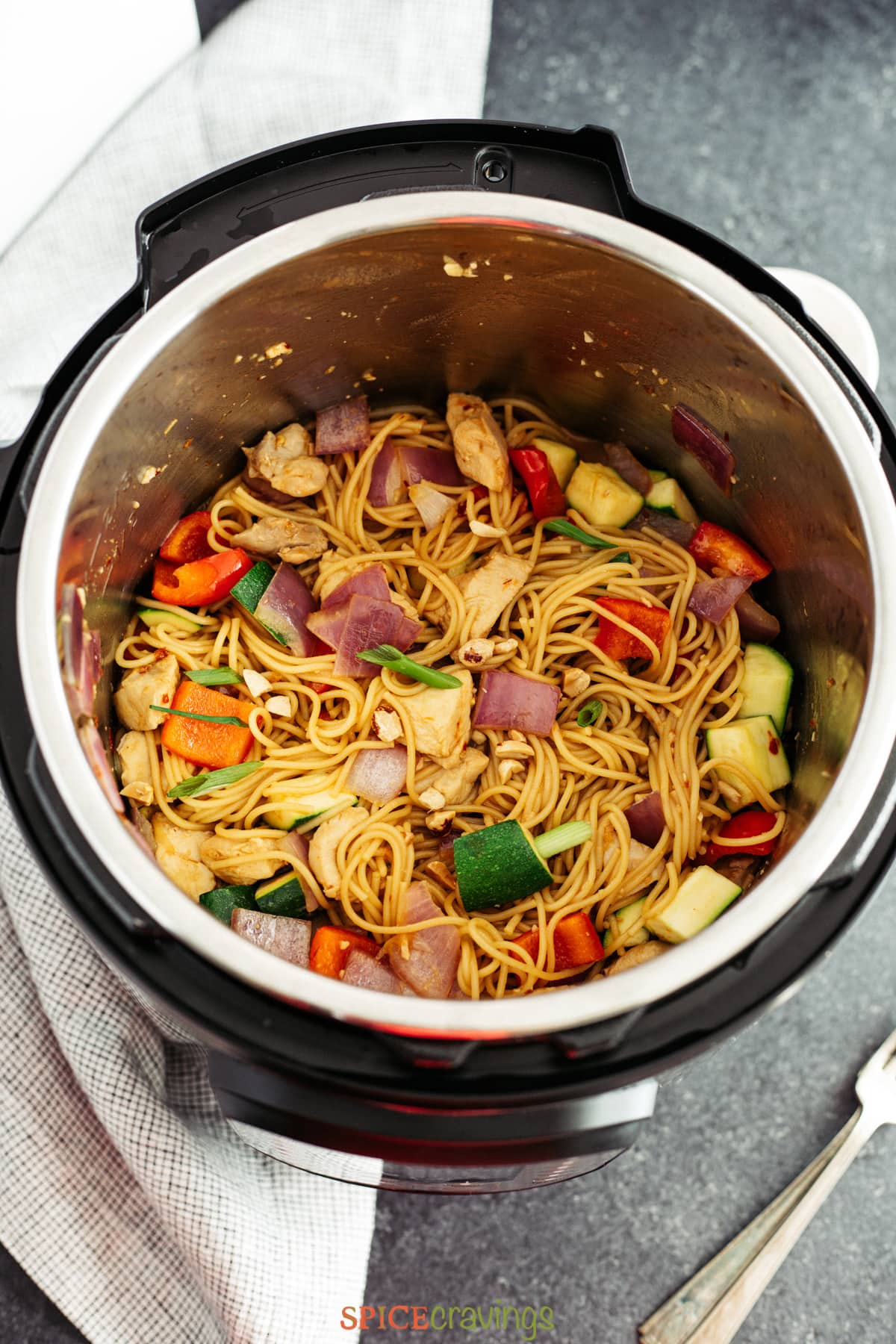
Ingredients- Notes & Substitutions
For convenience, I have divided the ingredients into three parts - pasta, sauce, and garnish. Here's what you need to make this famous California pizza kitchen kung pao spaghetti:

Spaghetti and chicken:
- Olive oil: A neutral oil like light olive or avocado oil.
- Zucchini: Cut the zucchini into ½-inch cubes.
- Red bell pepper: Cut into 1-inch pieces. Red bell pepper is the ripest, sweetest variety. You can use the orange or yellow, but a green bell pepper will have much more of a bite than the other colors.
- Onion: Use half of a white or yellow onion cut into 1-inch pieces.
- Chicken breast: I prefer to use boneless skinless chicken breast or thighs, cut into bite-size pieces. If using frozen, allow the chicken to thaw completely in the fridge overnight prior to cooking.
- Thin spaghetti noodles: You can use other noodles if you prefer, such as lo mein or egg noodles. You can also use gluten-free pasta for wheat-free spaghetti. You can find the adjusted cook times for different pasta shapes in this article.
- Water: Since the sauce is pretty flavorful, I use water. But you can certainly use your favorite broth instead, such as vegetables or chicken.
Kung Pao sauce:
- Soy sauce: Regular soy sauce is what I use here. Use tamari at a 1:1 ratio instead for a gluten-free option.
- Rice vinegar: Rice vinegar has a great, lightly sweet flavor, but you can also use apple cider vinegar.
- Chili garlic paste: I like to use sambal oelek or sriracha. If you don't have either, you can use red pepper flakes to taste, although the flavor won't be as deep.
- Sesame oil: Toasted sesame oil is thicker and more intensely flavored than the original, so use it to taste. If you don't have either, you can use olive or avocado oil.
- Sugar: A bit of sweetness rounds out Kung Pao sauce, so don't omit it.
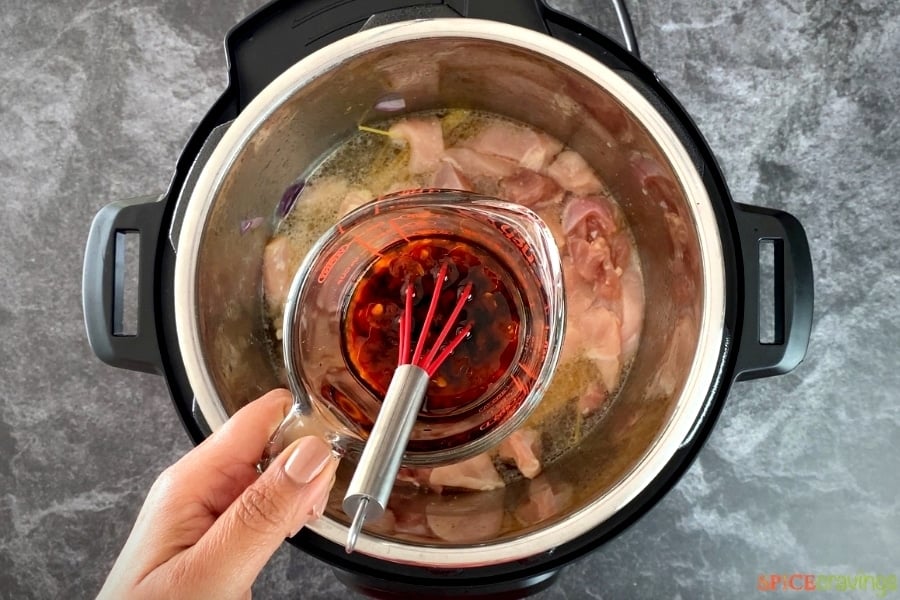
Garnish:
- Roasted peanuts: You can leave them out if you have a peanut allergy, but they do make this spaghetti truly Kung Pao.
- Spring onions: You can also use sliced shallots, finely diced onion, scallions, or chives.
Scroll to the recipe card for a detailed list of ingredients and quantities.
How to Make Kung Pao Spaghetti
Here are the step-by-step Instructions for CPK Kung Pao Spaghetti:
Cook the veggies: Preheat the Instant Pot and add 1 tablespoon olive oil, chopped onion, and bell pepper. Saute for 2 minutes. Add zucchini and saute another 1 minute. Remove and keep aside for later. (pic 1)
Saute garlic: Add the remaining tablespoon of olive oil and add minced garlic. Saute garlic for a minute, then cancel Saute. Add water (or broth) and use that to deglaze the pot, scraping off any bits of garlic stuck at the bottom. (pic 2)
Cook the spaghetti: Break the spaghetti in half. Layer in two batches in a criss-cross pattern. Gently tuck the spaghetti under the liquid. (pic 3)
Add the chicken: Spread the chicken all over the spaghetti. (pic 4)
Add the sauce: Stir the sauce once again and pour it all over the chicken. Close the lid and pressure cook for 4 minutes at high pressure. When done, manually release the pressure in bursts. Open after the pin has dropped. (pic 5)
Reduce sauce and add the vegetables: Turn on saute and simmer for 2-3 minutes until the sauce reduces and coats the spaghetti well. Cancel Saute.
Skip this step if making it for meal prep as the sauce will get absorbed by the pasta while cooling. Stir in the sautéed vegetables and stir with the spaghetti to warm them through. Garnish with thinly sliced spring onions and chopped peanuts and enjoy! (pic 6)
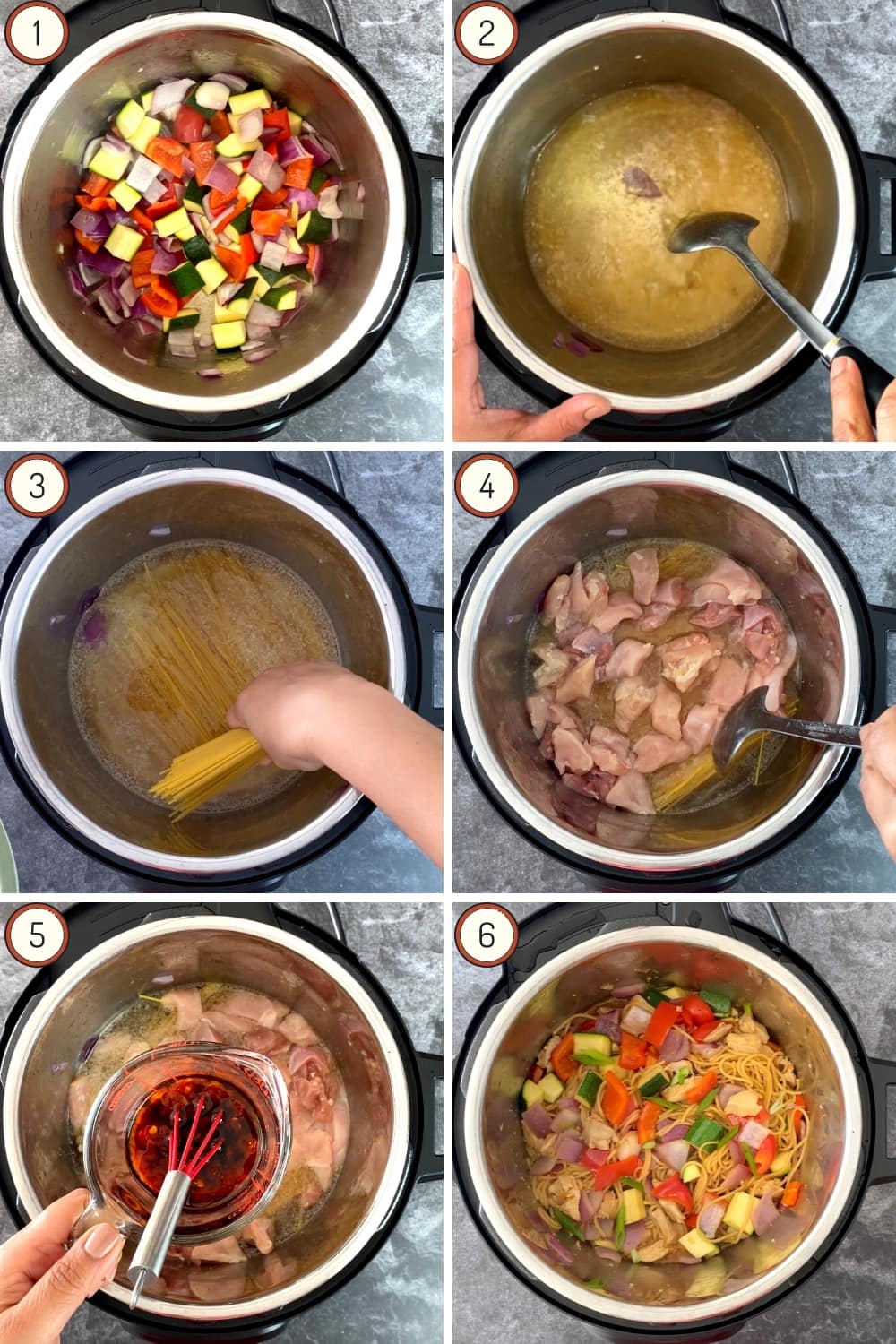
Serving Suggestion
I love to serve it with more crushed peanuts and sliced green onions. I also add some sambal oelek in a bowl for those who like their spaghetti extra spicy.
Variations to Try
- Make it vegetarian: Skip the chicken and add air-fried or baked tofu cubes after cooking the spaghetti and veggies.
- Add Shrimp: Skip the chicken or add shrimp in addition. To do that, heat the instant pot and saute shrimp with a pinch of salt and pepper until it turns opaque. Transfer on a plate and keep aside. Cook the noodles and veggies as per instructions and add the shrimp before serving.
How to Store
This pasta meal stores well in the fridge for up to 4 days. Store it in an airtight container.
If you are preparing this for meal prep, do not reduce the sauce as that gets absorbed into the pasta as it sits.
I don't recommend freezing any leftovers, as the pasta loses taste and texture upon thawing.
Recipe Tips & Notes
- Gluten-free Variation: Use gluten-free noodles and tamari instead of soy sauce for a gluten-free Kung Pao spaghetti. (Make sure to check the ingredients of the tamari to make sure it does not contain wheat.)
- Vegetarian Variation: Leave out the chicken or substitute it with cubed extra-firm tofu. Gently stir it in after pressure cooking so it retains its shape.
- Release pressure in bursts: This means, depending on your cooker model, press down or turn the pressure knob partially to release pressure 1-2 seconds at a time, then stop. Repeat this until most of the pressure has been released and its intensity has gone down. This prevents the starchy pasta water from spraying through the nozzle.
- Reduce the liquid after pressure cooking: When cooking pasta in an Instant Pot, you will always see excess liquid after pressure cooking. If you're eating right away, simmer the pasta for 2 to 3 minutes until that sauce reduces and coats the pasta. If making this for meal prep, leave it alone as the liquid will be soaked by the pasta as it cools.
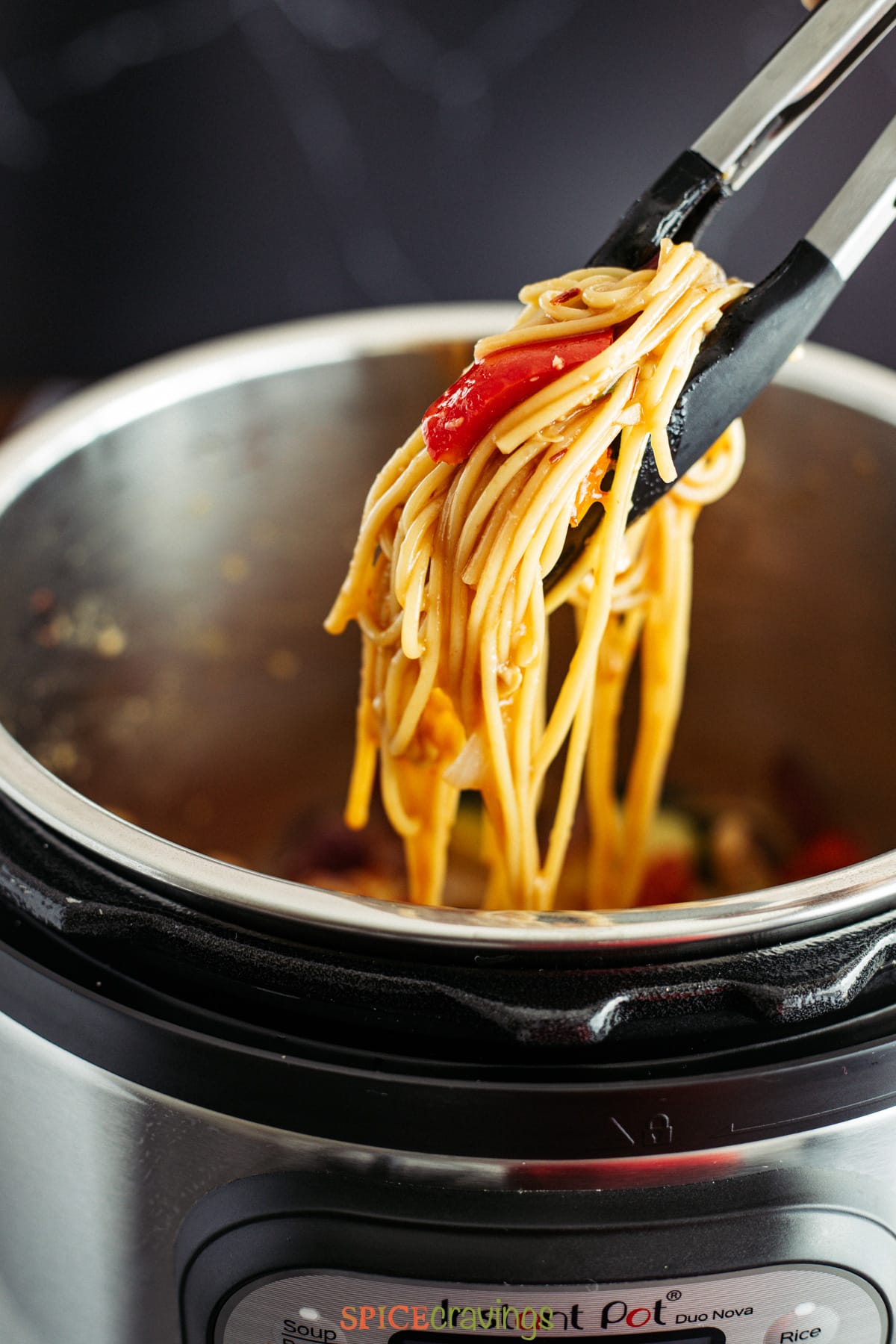
Frequently Asked Questions
Kung Pao style typically refers to a dish being stir-fried, then served in a spicy hot sauce, usually with peanuts.
Kung Po is another term for Kung Pao.
The sauce is savory, a little sweet and sour, and spicy.
Dried chilis are frequently used in Kung Pao chicken, but they can be quite spicy. Avoid eating them if you are averse to lots of spice.
While the ingredients can vary slightly, my Kung Pao sauce is made from soy sauce, rice vinegar, chili garlic paste, sesame oil, and sugar.
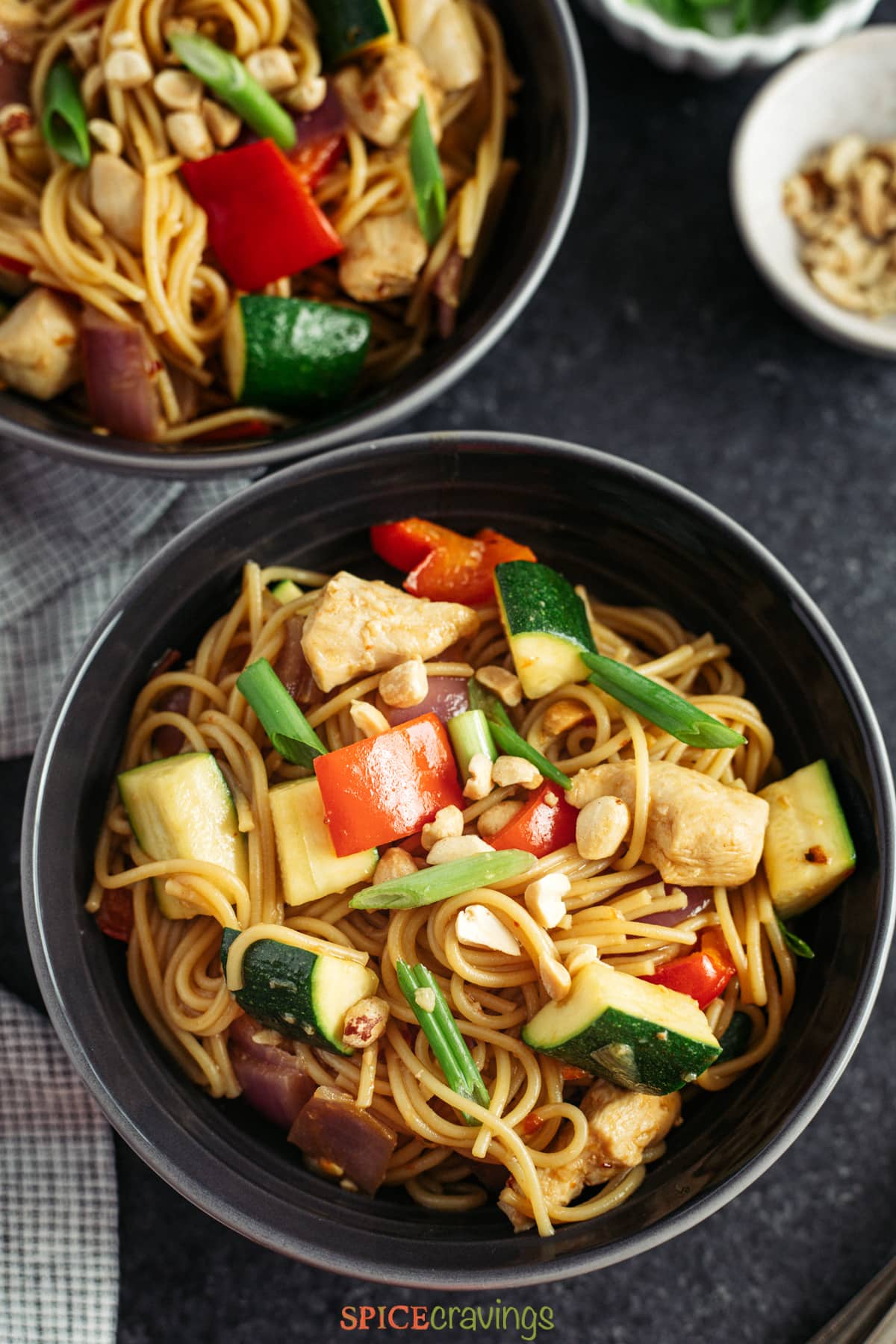
More One-Pot Pasta Meals
These recipes are part of the Instant Pot Pasta Recipes Collection:
★ Did you make this recipe? Please give it a star rating below! For more quick & easy recipes, FOLLOW ME on Facebook, Instagram, Pinterest and Youtube.
📖 Recipe
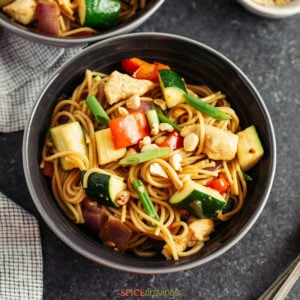
CPK's Kung Pao Spaghetti
Equipment
Ingredients
- 2 tablespoon olive oil divided
- 1 tablespoon minced garlic (3-4 cloves)
- 1 cup zucchini cut in ½-inch pieces
- 1 cup red bell pepper 1 bell pepper cut in 1-inch pieces
- ½ cup onion cut in 1-inch pieces (½ onion)
- 1 pound chicken breast cut in bite-size pieces
- 8 ounce thin spaghetti noodles (½ of a 1-pound box)
- 2 cups water or broth
Kung Pao Sauce
- 6 tablespoons soy sauce ¼ cup + 2 tablespoons
- 1 tablespoon rice vinegar or apple cider vinegar
- 1-2 tablespoon chili garlic paste (sambal oelek or sriracha)
- 2 teaspoon sesame oil
- 2 tablespoons sugar
Garnish
- ¼ cup roasted peanuts coarsely chopped
- ¼ cup spring onions thinly sliced at an angle (green stem only)
Instructions
- Preheat the Instant Pot on Saute, high. Add 1 tablespoon olive oil, chopped onion, and bell pepper. Saute for 2 minutes. Add zucchini and saute another 1 minute. Remove and keep aside for later.
- Add the remaining tablespoon of olive oil and add minced garlic. Saute garlic for a minute, then cancel saute. Add water (or broth) and use that to deglaze the pot, scrapping off any bits of garlic stuck at the bottom.
- Break the spaghetti in half. Layer in two batches in a criss-cross pattern. Gently tuck the spaghetti under the liquid.
- Spread the chicken all over the spaghetti.
- Stir the sauce once again and pour it all over the chicken.
- Close the lid on sealing position. Set pressure cook or manual for 4 minutes at high pressure. When the cook time is up, manually release the pressure in bursts. Open the lid only after all pressure has released and pin has dropped. Turn on saute and simmer for 2-3 minutes until the sauce reduces and coats the spaghetti well. Cancel Saute. Skip this step if making it for meal prep as the sauce will get absorbed by the pasta while cooling.
- Stir in the sautéed vegetables and stir with the spaghetti to warm them through. Garnish with thinly sliced spring onions and chopped peanuts and enjoy!
Video
Notes
- Gluten-free Variation: Use gluten-free noodles and tamari instead of soy sauce for a gluten-free Kung Pao spaghetti. (Make sure to check the ingredients of the tamari to make sure it does not contain wheat.)
- Vegetarian Variation: Leave out the chicken or substitute it with cubed extra-firm tofu. Gently stir it in after pressure cooking so it retains its shape.
- Release pressure in bursts: Which means, depending on your cooker model, press down or turn the pressure knob partially to release pressure 1-2 seconds at a time, then stop. Repeat this until most of the pressure has released and its intensity has gone down. This prevents the starchy pasta water from spraying through the nozzle.
- Reduce the liquid after pressure cooking: When cooking pasta in an Instant Pot, you will always see excess liquid after pressure cooking. If you're eating right away, simmer the pasta for 2 to 3 minutes until that sauce reduces and coats the pasta. If making this for meal prep, leave it along as the liquid will be soaked by the pasta as it cools.


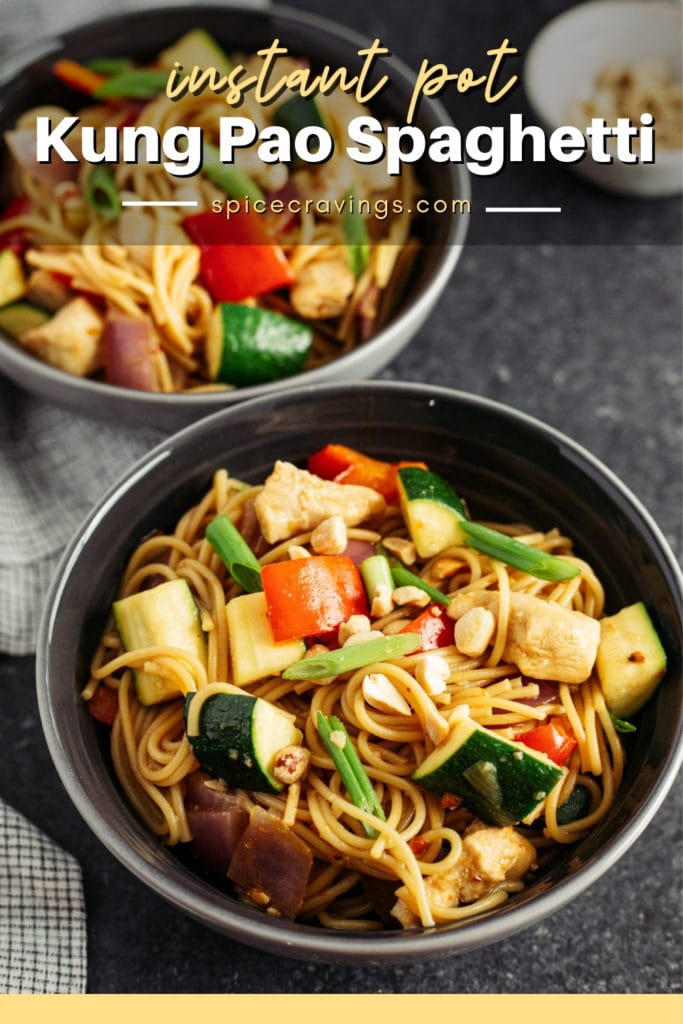

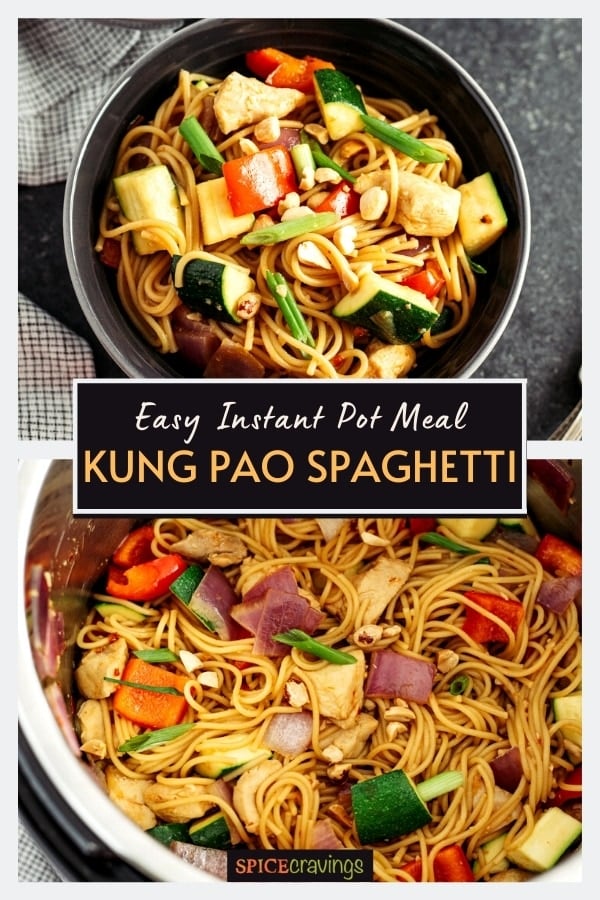
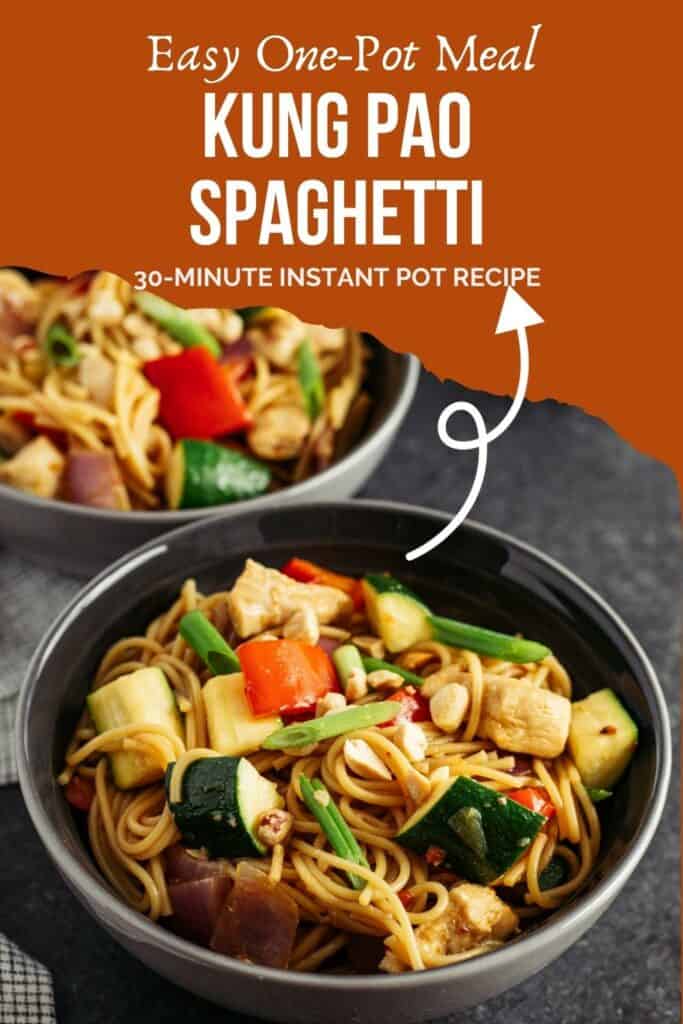
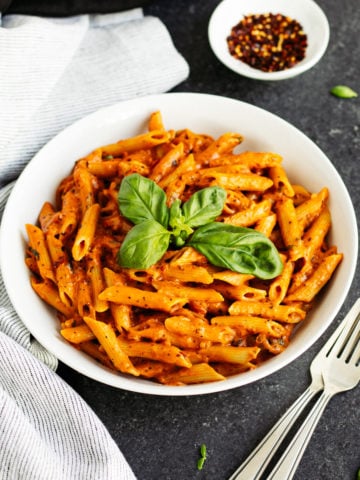
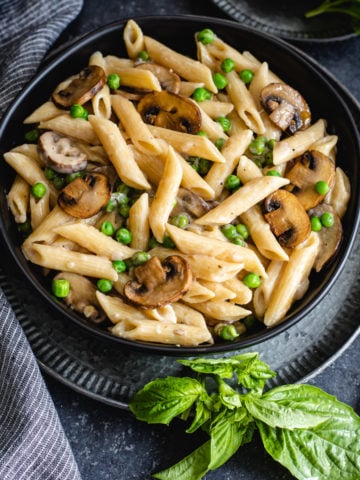
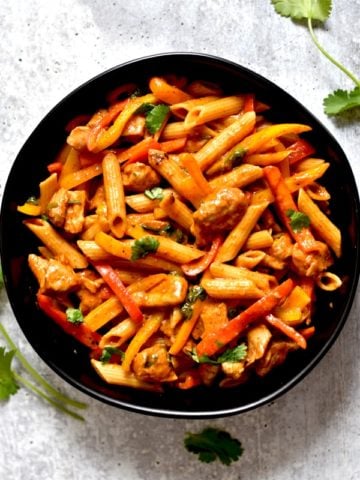
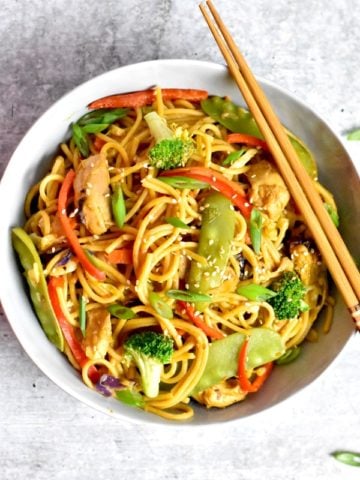
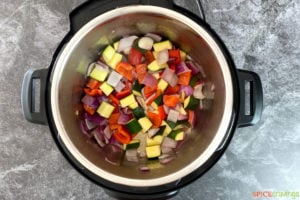
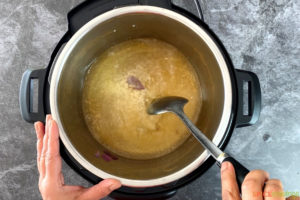
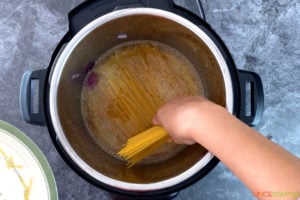
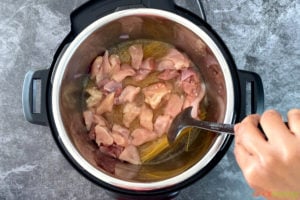
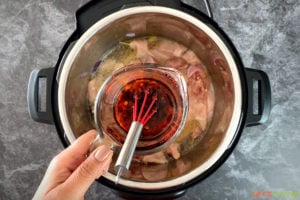
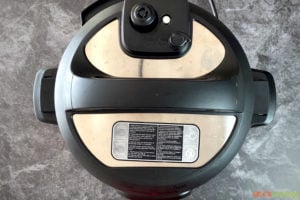
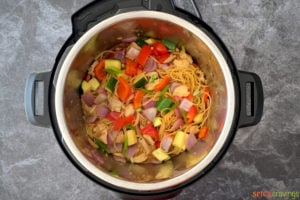
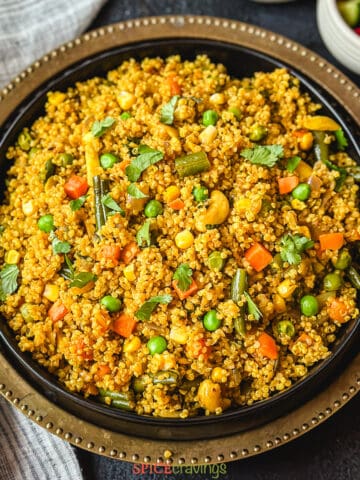
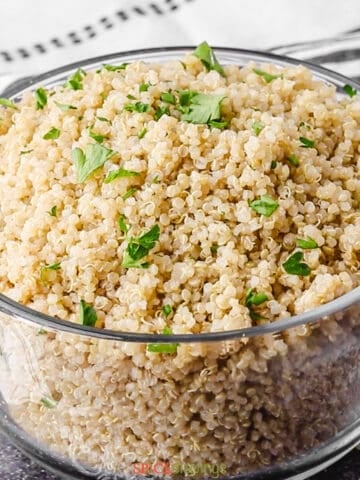
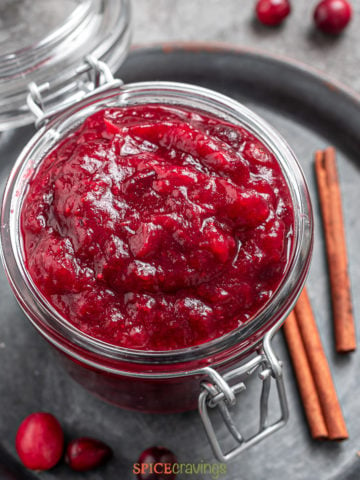
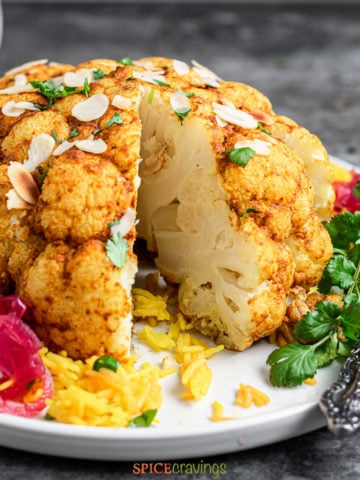

Leave a Reply